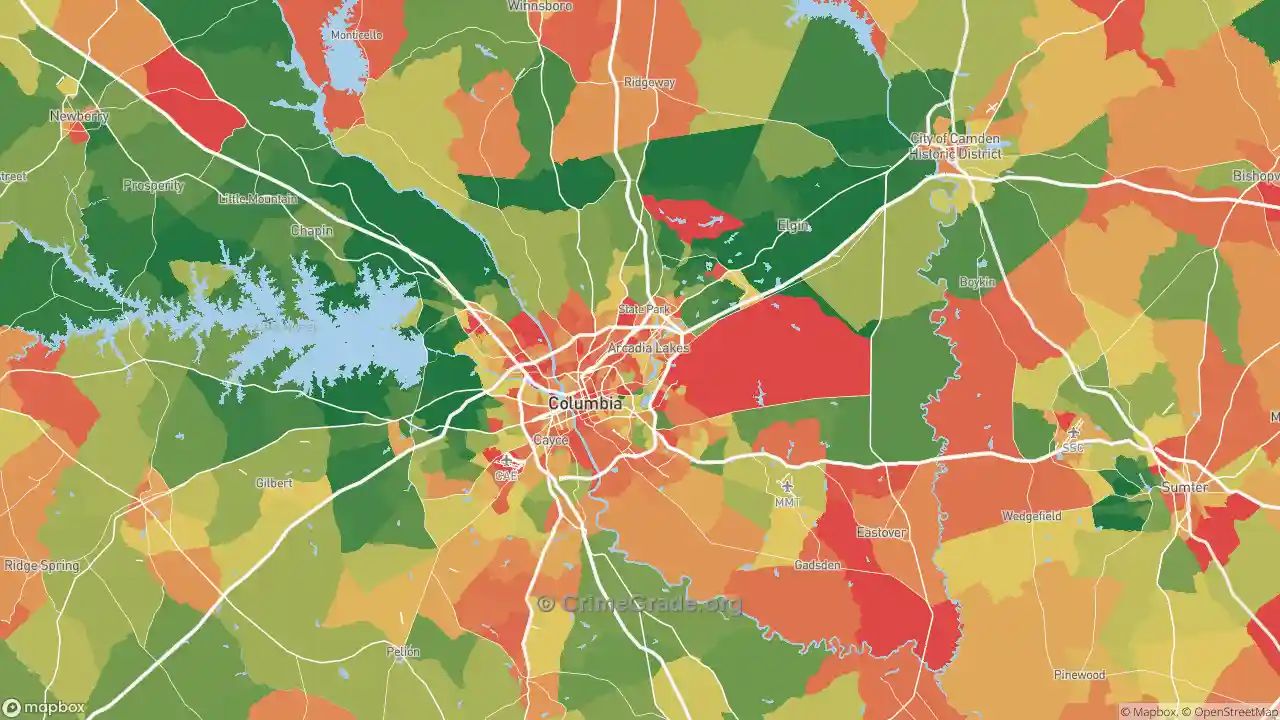Richland County stands as the second most populous county in South Carolina, housing roughly 415,759 inhabitants as of 2020. It encompasses the state capital, Columbia, alongside numerous other urban centers. Although Richland County offers an array of attractions and conveniences, certain regions suffer from elevated crime rates.
According to the FBI’s Uniform Crime Report, Richland County encountered a total of 16,544 criminal incidents in 2019, comprising 6,325 violent crimes and 10,219 property crimes. This results in a rate of 4,906 violent crimes and 7,419 property crimes per 100,000 residents, surpassing the national averages of 366.7 and 2,109.9, respectively.
Outlined below are the five most perilous neighborhoods in Richland County, South Carolina:
1. Arthurtown
Located in the south-central part of Columbia, Arthurtown is bounded by Shop Road, Beltline Boulevard, Rosewood Drive, and Bluff Road. Approximately 1,000 residents call it home, with a median household income of $21,875.
Among the most underprivileged and crime-stricken parts of Richland County, Arthurtown grapples with a violent crime rate of 1,720 per 100,000 inhabitants and a property crime rate of 11,200 per 100,000 residents.
The neighborhood contends with issues like drug trafficking, gang violence, prostitution, and vandalism. Residents also face environmental hazards such as flooding, pollution, and asbestos contamination.
Also Read:
2. Eastover
Situated in the southeastern area of Richland County along the Congaree River, Eastover’s population comprises about 800 people, with a median household income of $24,375. Another disadvantaged and crime-affected locale in Richland County, Eastover experiences a violent crime rate of 1,250 per 100,000 residents and a property crime rate of 10,000 per 100,000 residents.
The town has a history marked by racial tension, civil unrest, economic decline, and societal deterioration. Residents grapple with challenges including unemployment, illiteracy, substance abuse, and health concerns.
Also Read:
3. Gadsden
Found in the southwestern part of Richland County, close to the Congaree National Park, Gadsden houses around 1,500 residents, with a median household income of $28,750. As another high-crime region in Richland County, Gadsden faces a violent crime rate of 833 per 100,000 inhabitants and a property crime rate of 8,333 per 100,000 residents.
The community is notorious for its drug-related activities, particularly methamphetamine production and distribution. In addition, residents confront hardships such as poverty, unemployment, limited education, and inadequate infrastructure.
Also Read:
4. Dentsville
Dentsville, a census-designated place (CDP) in the northeastern part of Richland County along Two Notch Road, accommodates approximately 14,000 residents, with a median household income of $41,250. Similar to other high-crime areas in Richland County, Dentsville witnesses a violent crime rate of 706 per 1,000 residents and a property crime rate of 6.666 per 1,000 residents.
The CDP is characterized by a concentration of apartment complexes and commercial establishments that attract criminal activity. Residents also cope with challenges like traffic congestion, noise pollution, and urban sprawl.
Also Read:
5. Capitol View
Capitol View, a CDP in the northwestern section of Richland County along Broad River Road, hosts roughly 3,000 residents, with a median household income of $36,875. Another high-crime region in Richland County, Capitol View confronts a violent crime rate of 399 per 1,000 residents and a property crime rate of 3,487 per 1,000 residents.
The CDP encompasses multiple neighborhoods, each facing distinct challenges. Capitol View grapples with blight, neglect, and vandalism, while its residents deal with low income, limited education, and low homeownership.
Also Read:
In Conclusion
These five neighborhoods rank as the most dangerous in Richland County, South Carolina. Although these areas present numerous problems and risks, they also offer potential and opportunities for improvement.
Efforts and initiatives aimed at reducing crime and improving the quality of life within these neighborhoods encompass the Richland County Sheriff’s Department’s Community Action Team, the Richland County Neighborhood Improvement Program, the Richland County Community Development Corporation, and the Richland County Public Library’s Outreach Services.
These endeavors entail collaboration among various stakeholders, including law enforcement, government bodies, nonprofit organizations, businesses, and residents. Through collective efforts, these neighborhoods can surmount their challenges and achieve their goals.

